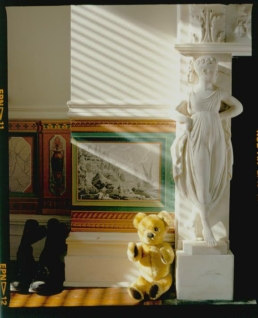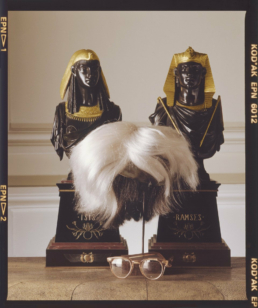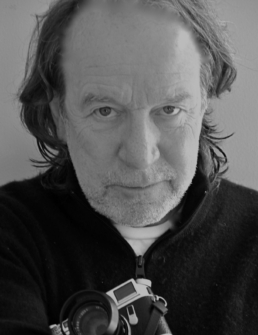David Gamble Takes Us Inside Andy Warhol’s Apartment
Eliza Jordan
APRIL 27, 2018 | DAVID GAMBLE
In 1987, the world slowed down as the passing of Andy Warhol hit headlines. After immediate attention was paid to the artist’s lifetime of achievement, his manager, Fred Hughes, hired trusted photographer to capture his untouched apartment before Warhol’s possessions were auctioned off by . was held over the course of a few weeks in April 1988. This month marks the 30th anniversary of that monumental , full of iconic Warhol items.
Since then, Gamble has gone on to gain recognition for photographing illustrious figures like the Dalai Lama, Stephen Hawking, and Margaret Thatcher, capturing images for magazines like Time and The Observer, and globally exhibiting work at places like the in London.

Whitewall spoke with Gamble about Warhol’s possessions, and what it said about his energetic, enigmatic personality.
WHITEWALL: When you were tasked by Hughes to photograph Warhol’s apartment, what did you feel at the time was most important for you to document?

DAVID GAMBLE: I hadn’t photographed a portrait of Andy. Because Andy had just died, I felt that I might find a way to make a portrait of him through the objects and the places he owned.
I wasn’t really interested in the value of the objects themselves; I was interested in why he would own something like that, and his taste. I was as much interested in photographing things that people didn’t real feel had any value. Around that time, Sotheby’s was obviously looking to see what objects were going to be of value for the auction, and I knew that the mundane and ordinary things were most likely not going to be touched. There was a different agenda for me, so that’s why I was fascinated by seeing the medicine cabinet and what was in the bathroom because there’s nothing of any real intrinsic value in there. It was just left. That’s what I really loved about that. The kitchen was very similar in that sense. The cookie jars were included in the auction. They were only worth 5 or 10 dollars, and they probably went, because Andy owned them, for 250 to 500 dollars. Sotheby’s and other auction houses realized that you didn’t need to have an object of value if it belonged to a celebrity. The Andy Warhol sale proved that a celebrity name would sell objects that didn’t have any real value. That was a real mark for auctions around the world.

WW: What were some unexpected treasures that you found in his apartment?
DG: I found his teddy bear in the bedroom. I liked the idea he had a teddy bear.

WW: Did you get to keep or take away any of the objects from the shoot?
DG: No, but my assistant did. It was strange because the food had already been cleared out of the cupboards in the kitchen, so when I looked, there was nothing in there. I was just interested to see if there was anything in there. But I put my hand in the back of one, and I found this Campbell’s can of tomato bisque and I went, “Wow, that’s cool.” Out of all the objects I could find left, right behind the back of the cupboard is this Campbell’s can. That was the only thing I introduced in the picture was the can on the kitchen sink. When I finished the shoot, my assistant said, “You know that can you found? Well, I’ve got it. I took it for you.” Interesting enough, I photographed the can ten years later just by itself and it was starting to rot inside and corrupt itself. I liked that idea. You were trying to take an object like something that Andy had, and through age, it was corrupting itself on the inside. I was thinking, “Well that’s sort of like Andy, being corrupted by time and by his death in the ground.” It was sort of my taking of Andy’s death through the can. I’m thinking about taking another picture of it 30 years later because it’s even more deteriorated.

WW: What about Warhol was surprising to you, that you found only through photographing his apartment?
DG: He had great taste at times. He could be really tacky and sort of cheap, and on the other side he knew quality when he saw it. A lot of the surprises in Andy’s house were the objects and pieces of furniture, which in themselves were really amazing pieces and very collectable in their own right. Andy had the eye to see that. I think that’s very cool.
WW: You’ve had so many wonderful opportunities to photograph influential people of today and the past. What has been a career highlight?
DG: There are no highlights in my career. [Laughs] It never felt really good when I received an award. The problem with receiving awards from anybody is that it’s always retrospective, meaning you are only ever given an award on something that you’ve already made. It doesn’t make me feel any better because I’d always like to think I’m better than the stuff I’ve already made, or I’m more interesting than that.
I like the idea of memories of certain events, and I like to talk about meeting Margaret Thatcher or Dalai Lama, or receiving awards in the South of France. All of these things are wonderful in themselves, but I can’t see them as really being highlights. I’m looking forward to the next thing I’m making.
WW: What do you enjoy photographing most? What brings you the most happiness when you work?
DG: Happiness. Oh. [Laughs] It’s sort of something that sits in my mind all of the time. I’m really involved with including or making references to the figurative. I’m really interested in the human condition, in the sense of what we feel like. All of the things that occupy my mind and my existence in the world, and the fact that a lot of people feel the same things I feel, I find a way to somehow transfer those things through photographs. When I’m shooting somebody else creating a painting of somebody else, it’s essentially referring to things that are familiar with yourself. Whoever you photograph or whatever you make is also a reflection of your own thinking—your own self. I suppose that’s really what all the work is about. When I photographed Andy’s apartment, I chose those objects because they set off a familiarity and recognition in me. In some ways, I photographed Andy through me. And when I photographed Margaret Thatcher and Stephen Hawking, it was through things that were familiar to me. That’s the whole point. I think the question of what makes me happy is trying to photograph or make an image of the human condition. And that includes objects. Sometimes, with an object, you can make it reflect a person as well as a person themselves.
WW: What are you working on now?
DG: I’m preparing for the April Sotheby’s auction of which two pieces have been selected. The watch, wig, glasses, and medicine cabinet from my Warhol series will be on display in a Sotheby’s exhibition at their NYC offices (April 4-9) and in the live auction on April 10. I’ve produced a series of gas compressed archival prints direct onto aluminum, special for the 30th anniversary, finished with Museum Plexiglas and white frame.
I’m working on a provocative new endeavor called “THE SILENCE” (a working title) that is dedicated to helping suffering women find their voices. There are those among us who are screaming for help as a consequence of sexual abuse and violence. This exhibition seeks to draw attention to their unheard cries for help, to acknowledge their pain, and amplify awareness of the many ways society attempts to inhibit and silence women.
I’m working on this 16mm black-and-white movie with a really great jazz composer here in New Orleans who’s a friend of mind. I’ve been shooting that over the last year. It’s just a pure collaboration of music and images, riffing and improvisational into one piece of art based on a street in New Orleans called Esplanade. It’s very avant-garde.
I’m also working on doing an Andy Warhol show in Chicago, too. Essentially, this whole year is really part of the fun to do this 30th anniversary of the Sotheby’s auction, so we’ll be doing a couple of shows. I want to do an installation experience with the Warhol house pictures… I’ll make a few life-size images, so you could actually look at the kitchen sink and the living room. It would be more like you’re walking into the environment of the house.
